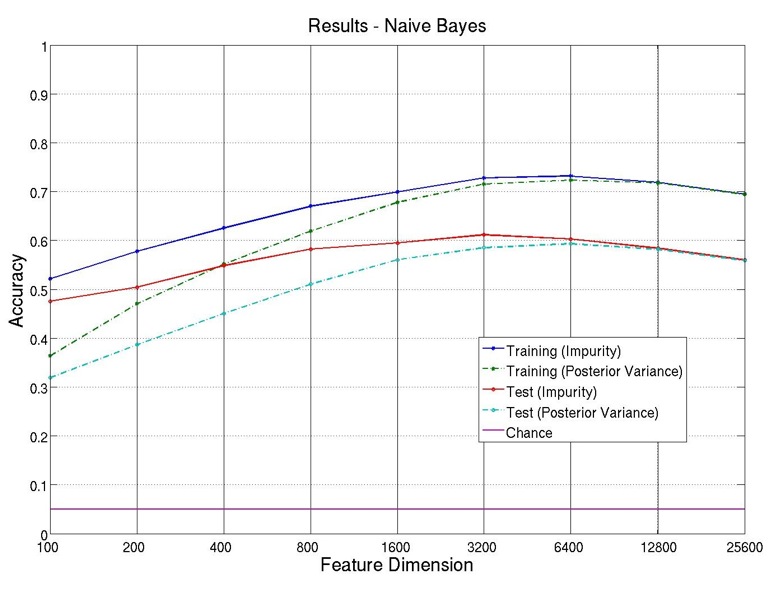
|
In this section, we discuss all the classifiers, as well as the multiple strategies of combining them, that we use in the classification task.
The basic single classifiers that we use are Na´ve Bayes, kNN, and Multi-SVM. We omit detailed
introduction of these classifiers since they are covered in our lectures as well as in the text
[1].
Each of the three actually corresponds to a set of classifiers in our experiments, since we have
different metrics and can select features of different dimensions. More specifically, we experiment
with both of our feature selection metrics: Impurity Measures and Posterior Variances, and of
nine different feature dimensions: {100,200,400,800,…,25600}.
Next we show the results of separately applying each of these three sets of classifiers on the
20Newsgroups data set.
Figure 3 shows the training and test accuracies of the set of Na´ve Bayes classifiers.
As can be seen, for both of the feature selection metrics, the highest training and test accuracies are achieved at the feature dimension of around 3200 and 6400. The highest test accuracy is around 61.1% and appears at the feature dimension of 3200. It is more than 10% higher than applying Na´ve Bayes on the original data set, and is only using about 5.2% of all the original features.
Figure 4 shows the training and test accuracies of the set of kNN classifiers. Note that not only
do these set of classifiers differ in the feature selection metrics and dimensions, we also
experiment on kNN with different values of the number of neighbors: k  {5,10,50,100}.
{5,10,50,100}.
As shown, there are roughly three clusters of curves, where the bottom cluster corresponds to
the test accuracies. Most of the test accuracies are below 30%, which are better than chance
(5%), but are still quite low compared to other sets of classifiers. This trend also agrees to that of
our preliminary results, suggesting that kNN might just not be a good choice for our information
classification task.
We use the one-versus-one strategy to implement the multi-class SVM. Namely for K labels, we
train  different binary SVMs (one for each pair of classes). Then for each test example we
assign its label according to the majority vote among all the binary classifiers. And for each
binary SVM, we use Sequential Minimal Optimization method to find the separating
hyperplane.
different binary SVMs (one for each pair of classes). Then for each test example we
assign its label according to the majority vote among all the binary classifiers. And for each
binary SVM, we use Sequential Minimal Optimization method to find the separating
hyperplane.
In our implementation, we use Matlab’s svmsmoset function to set the optimization
options, the svmtrain function to train the model and svmclassify functions to infer the
label.
When experimenting on low-dimensional data (d  {100,200,400}), trainings failed to
converge due to lack of enough features, and when on high-dimensional data (d
{100,200,400}), trainings failed to
converge due to lack of enough features, and when on high-dimensional data (d  {12800,25600}),
we encounter out of memory problems. Therefore, our results only include the ones from
experiments on data of dimensions d
{12800,25600}),
we encounter out of memory problems. Therefore, our results only include the ones from
experiments on data of dimensions d  {800,1600,3200,6400}.
{800,1600,3200,6400}.
Figure 5 shows the training and test accuracies of our experiments. It can be seen that the
training accuracy is almost 100% for all feature selection metrics and dimensions, and the test
accuracy gradually increases as feature dimension increases.
We experiment with the following set of classifier combination approaches.
The first three combination strategies are rather straightforward and contain little variability.
For Dynamic Classifier Selection, the key point is how to, for a test example, choose its
neighborhood among the training examples, since we will select a classifier to use depending on
the accuracies of all the classifiers on this neighborhood.
In our experiment, we, for each test example, select K-nearest data points from the training
set as its neighborhood (We tried carrying out the distance calculation on the original training
data, as well as on the different dimension-reduced training data corresponding to the specific
feature selection metric and dimension of each of the single classifiers. It turned out that the
former method worked better). We experiment with different K’s, in order to find a K that
produces the best result.
The results of these experiments are shown in Figure 6. We can see that, initially the accuracy
increases as the neighborhood enlarges, however, after the size reaches and goes beyond 640, the
accuracy stops increasing and remains relatively unchanged. Thus, we are picking K = 640 for
our dynamic selection combination strategy.
As previously discussed, the accuracies of all the kNN classifiers are quite low. So we carry out
two sets of combination experiments; one with kNN classifiers and the other without. The results
are shown in Figure 7.
As can be seen, excluding the kNN classifiers actually produces better results than including
them: it has no effects on highest confidence and dynamic selection methods, but brings improved
accuracies on random selection and majority vote methods. Therefore, we exclude the set of kNN
classifiers from the combination methods.